An Evaluation of Sustainable Power System Resilience in the Face of Severe Weather Conditions and Climate Changes: A Comprehensive Review of Current Advances
Abstract
:1. Introduction
- This review paper thoroughly examines the complexities of climate-related challenges, offering a perspective compared to broader literature reviews. The consequences of diverse weather scenarios were assessed carefully and emphasized tailored measures for each context. By categorizing these measures into short-term and long-term plannings, the crucial relationship between preparedness, timing, and disaster severity is elucidated, thus enhancing understanding of weather management strategies. Distinct from many review papers providing broad overviews, this survey offers insight into the specific planning measures suited for different hazards and time frames.
- Furthermore, it delved deeply into machine learning (ML) frameworks relevant to various weather scenarios, elucidating associated challenges and simulation tools/software. These frameworks are meticulously examined to identify vulnerable regions, emphasizing specificity. Through a comprehensive review, researchers will discover abundant opportunities for further development and gain insights into the challenges of deploying algorithms under diverse weather conditions.
- Also, this paper underscores the fundamental role of MGs during major events, stressing their integration with various technologies such as multi-MG formation, vehicle-to-home (V2H), vehicle-to-grid (V2G), and mobile power resources, particularly noteworthy being their role in black start (BS) restoration sequences.
2. Literature Survey
3. Resilience Evaluation Methods
4. Enhancing Resilience: Methods and Strategies
- Robustness/resistance: involves sustaining operations, remaining standing during disasters, or enduring low-probability, high-consequence events.
- Resourcefulness: encompasses effectively managing a disaster as it unfolds by identifying options, prioritizing control measures, and mitigating damage.
- Rapid recovery: aims to restore normalcy quickly after a disaster through contingency plans and emergency operations.
- Adaptability: involves learning from catastrophes and introducing new tools and technologies to enhance robustness, resourcefulness, and recovery before the occurrence of the next crisis.
4.1. Short-Term Resilience Planning
4.2. Long-Term Resilience Planning
4.3. Operational-Based vs. Planning-Based Restoration Strategies
4.4. Microgrid-Based Restoration Strategies
- Strategies for forming multiple MGs.
- Dynamic MG formation.
- Utilization of mobile energy resources.
- Establishment of networked MGs.
5. Conclusions
Author Contributions
Funding
Conflicts of Interest
References
- Mujjuni, F.; Betts, T.R.; Blanchard, R.E. Evaluation of Power Systems Resilience to Extreme Weather Events: A Review of Methods and Assumptions. IEEE Access 2023, 11, 87279–87296. [Google Scholar] [CrossRef]
- Bhusal, N.; Abdelmalak, M.; Kamruzzaman, M.; Benidris, M. Power System Resilience: Current Practices, Challenges, and Future Directions. IEEE Access 2020, 8, 18064–18086. [Google Scholar] [CrossRef]
- Rusco, F. Electricity Grid Resilience—Climate Change Is Expected to Have Far-Reaching Effects and DOE and FERC Should Take Actions; Technical Report; United States Government Accountability Office: Washington, DC, USA, 2021. [Google Scholar]
- Ren, H.; Hou, Z.J.; Ke, X.; Huang, Q.; Makatov, Y. Analysis of Weather and Climate Extremes Impact on Power System Outage. In Proceedings of the 2021 IEEE Power & Energy Society General Meeting (PESGM), Washington, DC, USA, 26–29 July 2021; pp. 1–5. [Google Scholar] [CrossRef]
- Eggleston, J.; Zuur, C.; Mancarella, P. From Security to Resilience: Technical and Regulatory Options to Manage Extreme Events in Low-Carbon Grids. IEEE Power Energy Mag. 2021, 19, 67–75. [Google Scholar] [CrossRef]
- Atrigna, M.; Buonanno, A.; Carli, R.; Cavone, G.; Scarabaggio, P.; Valenti, M.; Graditi, G.; Dotoli, M. A Machine Learning Approach to Fault Prediction of Power Distribution Grids Under Heatwaves. IEEE Trans. Ind. Appl. 2023, 59, 4835–4845. [Google Scholar] [CrossRef]
- Panossian, N. Power System Wildfire Risks and Potential Solutions: A Literature Review Proposed Metric; Technical Report; National Renewable Energy Laboratory: Golden, CO, USA, 2023. [Google Scholar]
- Panteli, M.; Mancarella, P. Influence of extreme weather and climate change on the resilience of power systems: Impacts and possible mitigation strategies. Electr. Power Syst. Res. 2015, 127, 259–270. [Google Scholar] [CrossRef]
- Kandaperumal, G.; Pandey, S.; Srivastava, A. AWR: Anticipate, Withstand, and Recover Resilience Metric for Operational and Planning Decision Support in Electric Distribution System. IEEE Trans. Smart Grid 2022, 13, 179–190. [Google Scholar] [CrossRef]
- Ton, D.T.; Wang, W.T.P. A More Resilient Grid: The U.S. Department of Energy Joins with Stakeholders in an R&D Plan. IEEE Power Energy Mag. 2015, 13, 26–34. [Google Scholar] [CrossRef]
- Zaboli, A.; Hong, J.; Tuyet-Doan, V.N.; Kim, Y.H. A Machine Learning-based Short-term Load Forecasting Method for Behind-the-meter DERs. In Proceedings of the 2023 IEEE Power & Energy Society General Meeting (PESGM), Orlando, FL, USA, 16–20 July 2023; pp. 1–5. [Google Scholar] [CrossRef]
- Zaboli, A.; Tuyet-Doan, V.N.; Kim, Y.H.; Hong, J.; Su, W. An LSTM-SAE-Based Behind-the-Meter Load Forecasting Method. IEEE Access 2023, 11, 49378–49392. [Google Scholar] [CrossRef]
- Bentivegna, E. Identifying Extreme Regimes in Climate-Scale Digital Twins: A Roadmap. In Proceedings of the 2022 IEEE International Conference on Big Data (Big Data), Osaka, Japan, 17–20 December 2022; pp. 4833–4834. [Google Scholar] [CrossRef]
- Luo, D.; Xia, Y.; Zeng, Y.; Li, C.; Zhou, B.; Yu, H.; Wu, Q. Evaluation Method of Distribution Network Resilience Focusing on Critical Loads. IEEE Access 2018, 6, 61633–61639. [Google Scholar] [CrossRef]
- Krishnamurthy, V.; Kwasinski, A. Effects of Power Electronics, Energy Storage, Power Distribution Architecture, and Lifeline Dependencies on Microgrid Resiliency during Extreme Events. IEEE J. Emerg. Sel. Top. Power Electron. 2016, 4, 1310–1323. [Google Scholar] [CrossRef]
- Ciapessoni, E.; Cirio, D.; Pitto, A. A Cost–Benefit Analysis Framework for Power System Resilience Enhancement Based on Optimization via Simulation Considering Climate Changes and Cascading Outages. Energies 2023, 16, 5160. [Google Scholar] [CrossRef]
- Araújo, K.; Shropshire, D. A meta-level framework for evaluating resilience in net-zero carbon power systems with extreme weather events in the United States. Energies 2021, 14, 4243. [Google Scholar] [CrossRef]
- Zafeiropoulou, M.; Sijakovic, N.; Zarkovic, M.; Ristic, V.; Terzic, A.; Makrygiorgou, D.; Zoulias, E.; Vita, V.; Maris, T.I.; Fotis, G. A Flexibility Platform for Managing Outages and Ensuring the Power System’s Resilience during Extreme Weather Conditions. Processes 2023, 11, 3432. [Google Scholar] [CrossRef]
- Bayani, R.; Manshadi, S.D. Resilient Expansion Planning of Electricity Grid Under Prolonged Wildfire Risk. IEEE Trans. Smart Grid 2023, 14, 3719–3731. [Google Scholar] [CrossRef]
- Sun, N.; Zhang, S.; Peng, T.; Zhou, J.; Sun, X. A Composite Uncertainty Forecasting Model for Unstable Time Series: Application of Wind Speed and Streamflow Forecasting. IEEE Access 2020, 8, 209251–209266. [Google Scholar] [CrossRef]
- Emily, B. Extreme Weather Is Causing More U.S. Power Outages. But There Are Solutions. TIME, 24 September 2021. [Google Scholar]
- Bie, Z.; Lin, Y.; Li, G.; Li, F. Battling the Extreme: A Study on the Power System Resilience. Proc. IEEE 2017, 105, 1253–1266. [Google Scholar] [CrossRef]
- Liang, G.; Jing, J.; Hao, W.; Wang, Z.; Zhou, F.; Wei, Y. Resilience Enhancement Strategy Considering Faulty Equipment Repair and Multiple Resource Dispatch for Power Distribution Networks. In Proceedings of the 2023 International Conference on Power System Technology (PowerCon), Jinan, China, 21–22 September 2023; pp. 1–5. [Google Scholar] [CrossRef]
- Chi, Y.; Xu, Y.; Hu, C.; Feng, S. A State-of-the-Art Literature Survey of Power Distribution System Resilience Assessment. In Proceedings of the 2018 IEEE Power & Energy Society General Meeting (PESGM), Portland, OR, USA, 5–10 August 2018; pp. 1–5. [Google Scholar] [CrossRef]
- Arif, A.; Wang, Z.; Chen, C.; Chen, B. A Stochastic Multi-Commodity Logistic Model for Disaster Preparation in Distribution Systems. IEEE Trans. Smart Grid 2020, 11, 565–576. [Google Scholar] [CrossRef]
- Kotikot, S.M.; Kar, B.; Omitaomu, O.A. A Geospatial Framework Using Multicriteria Decision Analysis for Strategic Placement of Reserve Generators in Puerto Rico. IEEE Trans. Eng. Manag. 2020, 67, 659–669. [Google Scholar] [CrossRef]
- Sun, S.; Lyu, Q.; Li, G.; Lin, Y.; Bie, Z.; Wen, W. Resilience Modeling and Assessment for Power Distribution Systems Under Typhoon Disasters. In Proceedings of the 2019 IEEE Sustainable Power and Energy Conference (iSPEC), Beijing, China, 21–23 November 2019; pp. 2413–2418. [Google Scholar] [CrossRef]
- Wang, Y.; Huang, T.; Li, X.; Tang, J.; Wu, Z.; Mo, Y.; Xue, L.; Zhou, Y.; Niu, T.; Sun, S. A Resilience Assessment Framework for Distribution Systems Under Typhoon Disasters. IEEE Access 2021, 9, 155224–155233. [Google Scholar] [CrossRef]
- Arab, A.; Khodaei, A.; Eskandarpour, R.; Thompson, M.P.; Wei, Y. Three Lines of Defense for Wildfire Risk Management in Electric Power Grids: A Review. IEEE Access 2021, 9, 61577–61593. [Google Scholar] [CrossRef]
- Trakas, D.N.; Hatziargyriou, N.D. Optimal Distribution System Operation for Enhancing Resilience Against Wildfires. IEEE Trans. Power Syst. 2018, 33, 2260–2271. [Google Scholar] [CrossRef]
- Yao, F.; Chau, T.K.; Zhang, X.; Iu, H.H.C.; Fernando, T. An Integrated Transmission Expansion and Sectionalizing-Based Black Start Allocation of BESS Planning Strategy for Enhanced Power Grid Resilience. IEEE Access 2020, 8, 148968–148979. [Google Scholar] [CrossRef]
- Liu, F.; Chen, C.; Lin, C.; Li, G.; Xie, H.; Bie, Z. Utilizing Aggregated Distributed Renewable Energy Sources With Control Coordination for Resilient Distribution System Restoration. IEEE Trans. Sustain. Energy 2023, 14, 1043–1056. [Google Scholar] [CrossRef]
- Kim, J.; Dvorkin, Y. Enhancing Distribution System Resilience With Mobile Energy Storage and Microgrids. IEEE Trans. Smart Grid 2019, 10, 4996–5006. [Google Scholar] [CrossRef]
- Ghayoor, F.; Ghannadpour, S.F.; Zaboli, A. Power network-planning optimization considering average power not supplied reliability index: Modified by chance-constrained programming. Comput. Ind. Eng. 2022, 164, 107900. [Google Scholar] [CrossRef]
- Du, Y.; Tu, H.; Lu, X.; Wang, J.; Lukic, S. Black-Start and Service Restoration in Resilient Distribution Systems with Dynamic Microgrids. IEEE J. Emerg. Sel. Top. Power Electron. 2022, 10, 3975–3986. [Google Scholar] [CrossRef]
- Ghayoor, F.; Zaboli, A.; Ghannadpour, S.F. A Coordinated Power Grid optimization Considering Reliability and Chance-Constrained Approaches. In Proceedings of the 2023 IEEE Kansas Power and Energy Conference (KPEC), Manhattan, KS, USA, 27–28 April 2023; pp. 1–6. [Google Scholar] [CrossRef]
- Qiu, D.; Wang, Y.; Wang, J.; Zhang, N.; Strbac, G.; Kang, C. Resilience-Oriented Coordination of Networked Microgrids: A Shapley Q-Value Learning Approach. IEEE Trans. Power Syst. 2023, 39, 3401–3416. [Google Scholar] [CrossRef]
- Panteli, M.; Mancarella, P. The Grid: Stronger, Bigger, Smarter? Presenting a Conceptual Framework of Power System Resilience. IEEE Power Energy Mag. 2015, 13, 58–66. [Google Scholar] [CrossRef]
- Kwasinski, A. Quantitative Model and Metrics of Electrical Grids’ Resilience Evaluated at a Power Distribution Level. Energies 2016, 9, 93. [Google Scholar] [CrossRef]
- Liu, X.; Shahidehpour, M.; Li, Z.; Liu, X.; Cao, Y.; Bie, Z. Microgrids for Enhancing the Power Grid Resilience in Extreme Conditions. IEEE Trans. Smart Grid 2017, 8, 589–597. [Google Scholar] [CrossRef]
- Panteli, M.; Mancarella, P.; Trakas, D.N.; Kyriakides, E.; Hatziargyriou, N.D. Metrics and Quantification of Operational and Infrastructure Resilience in Power Systems. IEEE Trans. Power Syst. 2017, 32, 4732–4742. [Google Scholar] [CrossRef]
- Chanda, S.; Srivastava, A.K.; Mohanpurkar, M.U.; Hovsapian, R. Quantifying Power Distribution System Resiliency Using Code-Based Metric. IEEE Trans. Ind. Appl. 2018, 54, 3676–3686. [Google Scholar] [CrossRef]
- Panteli, M.; Pickering, C.; Wilkinson, S.; Dawson, R.; Mancarella, P. Power System Resilience to Extreme Weather: Fragility Modeling, Probabilistic Impact Assessment, and Adaptation Measures. IEEE Trans. Power Syst. 2017, 32, 3747–3757. [Google Scholar] [CrossRef]
- Mohamed, M.A.; Chen, T.; Su, W.; Jin, T. Proactive Resilience of Power Systems Against Natural Disasters: A Literature Review. IEEE Access 2019, 7, 163778–163795. [Google Scholar] [CrossRef]
- Zhu, X.; Zeng, B.; Li, Y.; Liu, J. Co-Optimization of Supply and Demand Resources for Load Restoration of Distribution System Under Extreme Weather. IEEE Access 2021, 9, 122907–122923. [Google Scholar] [CrossRef]
- Poudel, S.; Dubey, A. Critical Load Restoration Using Distributed Energy Resources for Resilient Power Distribution System. IEEE Trans. Power Syst. 2019, 34, 52–63. [Google Scholar] [CrossRef]
- Billinton, R.; Wu, C.; Singh, G. Extreme adverse weather modeling in transmission and distribution system reliability evaluation. In Proceedings of the 14th Power Systems Computation Conference, Seville, Spain, 24–28 June 2002. [Google Scholar]
- Chaidez, A.; Sang, Y. Optimal Energy Portfolio Planning for Power System Considering the Impact of Winter Storms. In Proceedings of the 2021 North American Power Symposium (NAPS), College Station, TX, USA, 14–16 November 2021; pp. 1–5. [Google Scholar] [CrossRef]
- Bhat, R.; Darestani, Y.M.; Shafieezadeh, A.; Meliopoulos, A.; DesRoches, R. Resilience Assessment of Distribution Systems Considering the Effect of Hurricanes. In Proceedings of the 2018 IEEE/PES Transmission and Distribution Conference and Exposition (T&D), Denver, CO, USA, 16–19 April 2018; pp. 1–5. [Google Scholar] [CrossRef]
- Yang, Z.; Martí, A.; Chen, Y.; Martí, J.R. Optimal Resource Allocation to Enhance Power Grid Resilience Against Hurricanes. IEEE Trans. Power Syst. 2023, 38, 2621–2629. [Google Scholar] [CrossRef]
- Aquino, J.; Nazaripouya, H. Methods Utilized to Improve Resilience of Power Systems Against Ice Storms. In Proceedings of the 2022 IEEE International Conference on Environment and Electrical Engineering and 2022 IEEE Industrial and Commercial Power Systems Europe (EEEIC/I&CPS Europe), Prague, Czech Republic, 28 June–1 July 2022; pp. 1–5. [Google Scholar] [CrossRef]
- Norris, T. Power systems in emergencies—From contingency planning to crisis management. IEE Rev. 2001, 47, 28. [Google Scholar]
- Shafieezadeh, A.; Onyewuchi, U.P.; Begovic, M.M.; DesRoches, R. Age-Dependent Fragility Models of Utility Wood Poles in Power Distribution Networks Against Extreme Wind Hazards. IEEE Trans. Power Deliv. 2014, 29, 131–139. [Google Scholar] [CrossRef]
- Gazijahani, F.S.; Salehi, J.; Shafie-khah, M. Benefiting from Energy-Hub Flexibilities to Reinforce Distribution System Resilience: A Pre- and Post-Disaster Management Model. IEEE Syst. J. 2022, 16, 3381–3390. [Google Scholar] [CrossRef]
- Yadav, M.; Pal, N.; Saini, D.K. Microgrid Control, Storage, and Communication Strategies to Enhance Resiliency for Survival of Critical Load. IEEE Access 2020, 8, 169047–169069. [Google Scholar] [CrossRef]
- Igder, M.A.; Liang, X. Service Restoration Using Deep Reinforcement Learning and Dynamic Microgrid Formation in Distribution Networks. IEEE Trans. Ind. Appl. 2023, 59, 5453–5472. [Google Scholar] [CrossRef]
- Mohan, G.N.V.; Bhende, C.N.; Srivastava, A.K. Intelligent Control of Battery Storage for Resiliency Enhancement of Distribution System. IEEE Syst. J. 2022, 16, 2229–2239. [Google Scholar] [CrossRef]
- Ambia, M.N.; Meng, K.; Xiao, W.; Dong, Z.Y. Nested Formation Approach for Networked Microgrid Self-Healing in Islanded Mode. IEEE Trans. Power Deliv. 2021, 36, 452–464. [Google Scholar] [CrossRef]
- Guov, V.; Cao, Y.; Beil, I. Islanding of a Topologically Realistic Rural Grid Using Grid-Forming Inverters. In Proceedings of the 2022 IEEE 13th International Symposium on Power Electronics for Distributed Generation Systems (PEDG), Kiel, Germany, 26–29 June 2022; pp. 1–6. [Google Scholar] [CrossRef]
- D’silva, S.; Shadmand, M.B.; Abu-Rub, H. Microgrid Control Strategies for Seamless Transition Between Grid-Connected and Islanded Modes. In Proceedings of the 2020 IEEE Texas Power and Energy Conference (TPEC), College Station, TX, USA, 6–7 February 2020; pp. 1–6. [Google Scholar] [CrossRef]
- Office of Electricity. Grid Systems. 2024. Available online: https://www.energy.gov/oe/grid-systems (accessed on 20 March 2024).
- Udoakah, Y.O.; Sonder, H.B.; Liang, J.; Cipcigan, L. Development of a viable black start restoration pathway and problem formulation sequence. In Proceedings of the 2022 IEEE 7th International Energy Conference (ENERGYCON), Riga, Latvia, 9–12 May 2022; pp. 1–6. [Google Scholar]
- Poudel, S.; Mukherjee, M.; Jinsiwale, R.A.; Hanif, S. Resilience Assessment Framework For Distribution Systems Performance Under Extreme Conditions. In Proceedings of the 2023 IEEE Power & Energy Society Innovative Smart Grid Technologies Conference (ISGT), Washington, DC, USA, 16–19 January 2023; pp. 1–5. [Google Scholar]
- Tan, Z.; Fan, R.; Liu, Y.; Sun, L. Microgrid black-start after natural disaster with load restoration using spanning tree search. In Proceedings of the 2016 IEEE Power and Energy Society General Meeting (PESGM), Boston, MA, USA, 17–21 July 2016; pp. 1–5. [Google Scholar]
- Hamidieh, M.; Ghassemi, M. Microgrids and resilience: A review. IEEE Access 2022, 10, 106059–106080. [Google Scholar] [CrossRef]
- El-Faouri, F.S.; Alzahlan, M.W.; Batarseh, M.G.; Mohammad, A.; Za’ter, M.E. Modeling of a microgrid’s power generation cost function in real-time operation for a highly fluctuating load. Simul. Model. Pract. Theory 2019, 94, 118–133. [Google Scholar] [CrossRef]
- 1547.4-2011; IEEE Guide for Design, Operation, and Integration of Distributed Resource Island Systems with Electric Power Systems. IEEE: New York, NY, USA, 2011.
- Zhao, J.; Li, F.; Mukherjee, S.; Sticht, C. Deep reinforcement learning-based model-free on-line dynamic multi-microgrid formation to enhance resilience. IEEE Trans. Smart Grid 2022, 13, 2557–2567. [Google Scholar] [CrossRef]
- Simental, O.Q.; Mandal, P.; Galvan, E.; Wang, Z. Leveraging Distributed EVs and PVs to Assess Networked Microgrids Resilience Against Extreme Weather Event. In Proceedings of the 2022 IEEE Power & Energy Society General Meeting (PESGM), Denver, CO, USA, 17–21 July 2022; pp. 1–5. [Google Scholar]
- Wang, Y.; Qiu, D.; Teng, F.; Strbac, G. Towards microgrid resilience enhancement via mobile power sources and repair crews: A multi-agent reinforcement learning approach. IEEE Trans. Power Syst. 2023, 39, 1329–1345. [Google Scholar] [CrossRef]
- Denysiuk, S.; Derevianko, D. Optimisation features of energy processes in energy systems with Distributed Generation. In Proceedings of the 2020 IEEE 7th International Conference on Energy Smart Systems (ESS), Kyev, Ukraine, 12–14 May 2020; pp. 211–214. [Google Scholar]
- Singh, S.; Gao, D.W.; Giraldez, J. Cost analysis of renewable energy-based microgrids. In Proceedings of the 2017 North American Power Symposium (NAPS), Morgantown, WV, USA, 17–19 September 2017; pp. 1–4. [Google Scholar]
- Stevenson, A.; Riggs, H.; Khan, M.A.; Sarwat, A. Estimating Cost of Electricity of Resilient PV-based Grid-Tied Microgrids. In Proceedings of the 2023 IEEE Green Technologies Conference (GreenTech), Denver, CO, USA, 19–21 April 2023; pp. 15–19. [Google Scholar]
- Dugan, J.; Mohagheghi, S.; Kroposki, B. Application of Mobile Energy Storage for Enhancing Power Grid Resilience: A Review. Energies 2021, 14, 6476. [Google Scholar] [CrossRef]
- Chen, Y.; Pei, W.; Ma, T.; Xiao, H. Asymmetric Nash bargaining model for peer-to-peer energy transactions combined with shared energy storage. Energy 2023, 278, 127980. [Google Scholar] [CrossRef]
- Zhang, L.; Huang, J.; Tang, W.; Hou, Y.; Wang, Z.; Xie, F.; Fan, W. Equilibrium allocation of ESSs in multiple UIESs-accessed distribution networks considering the resilience and economic benefits. IEEE Trans. Ind. Appl. 2023, 59, 5230–5242. [Google Scholar] [CrossRef]
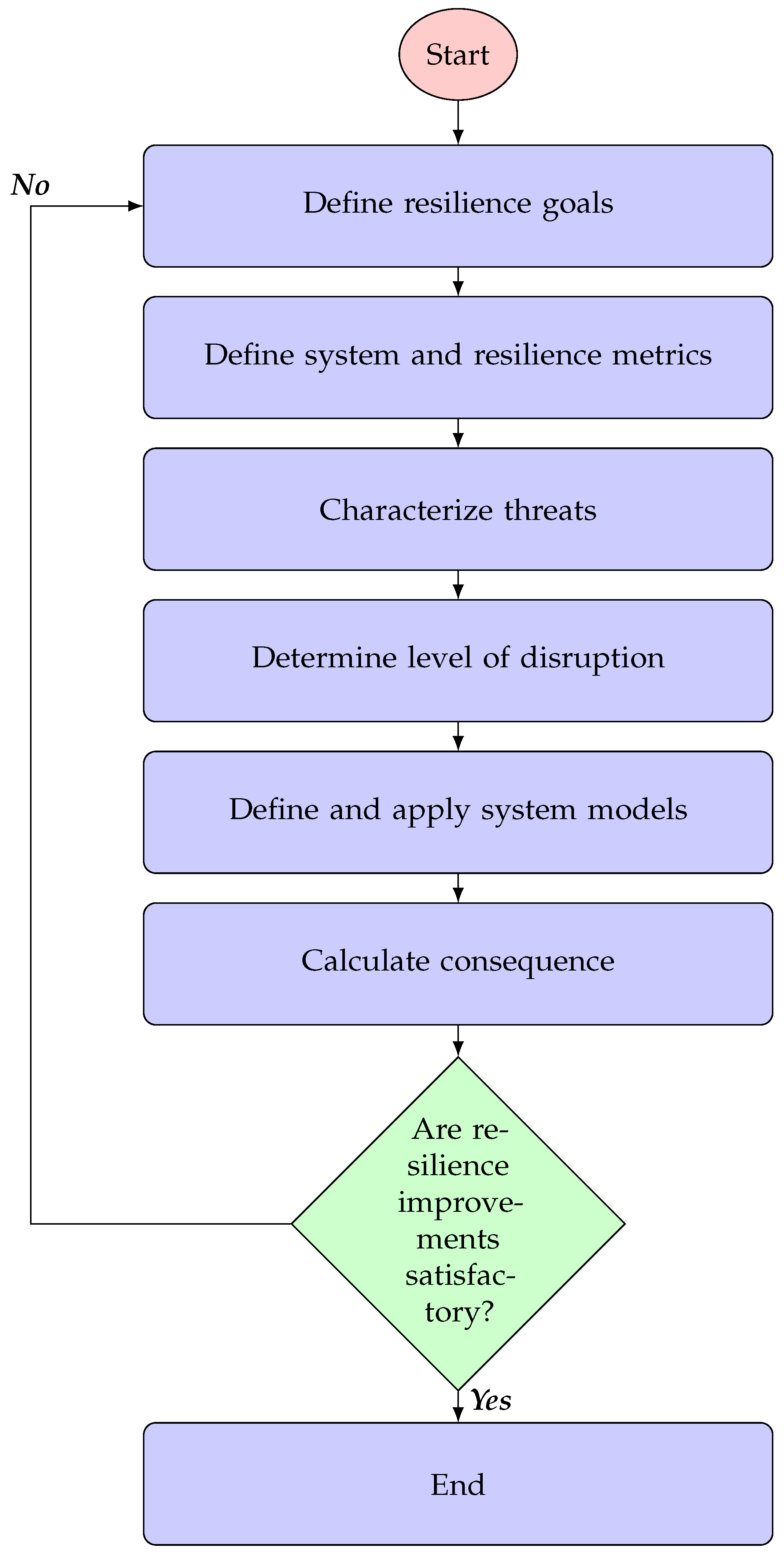
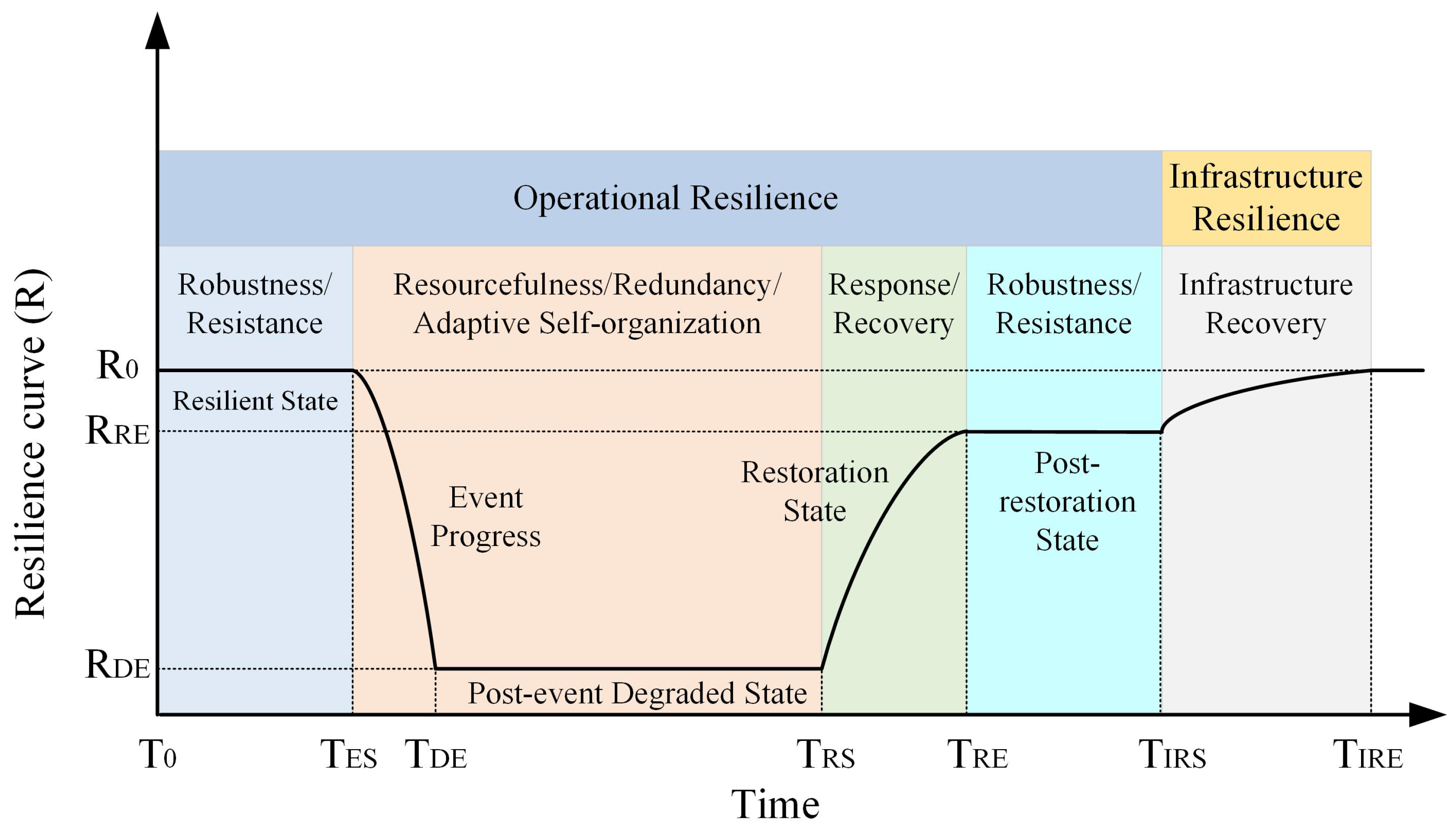

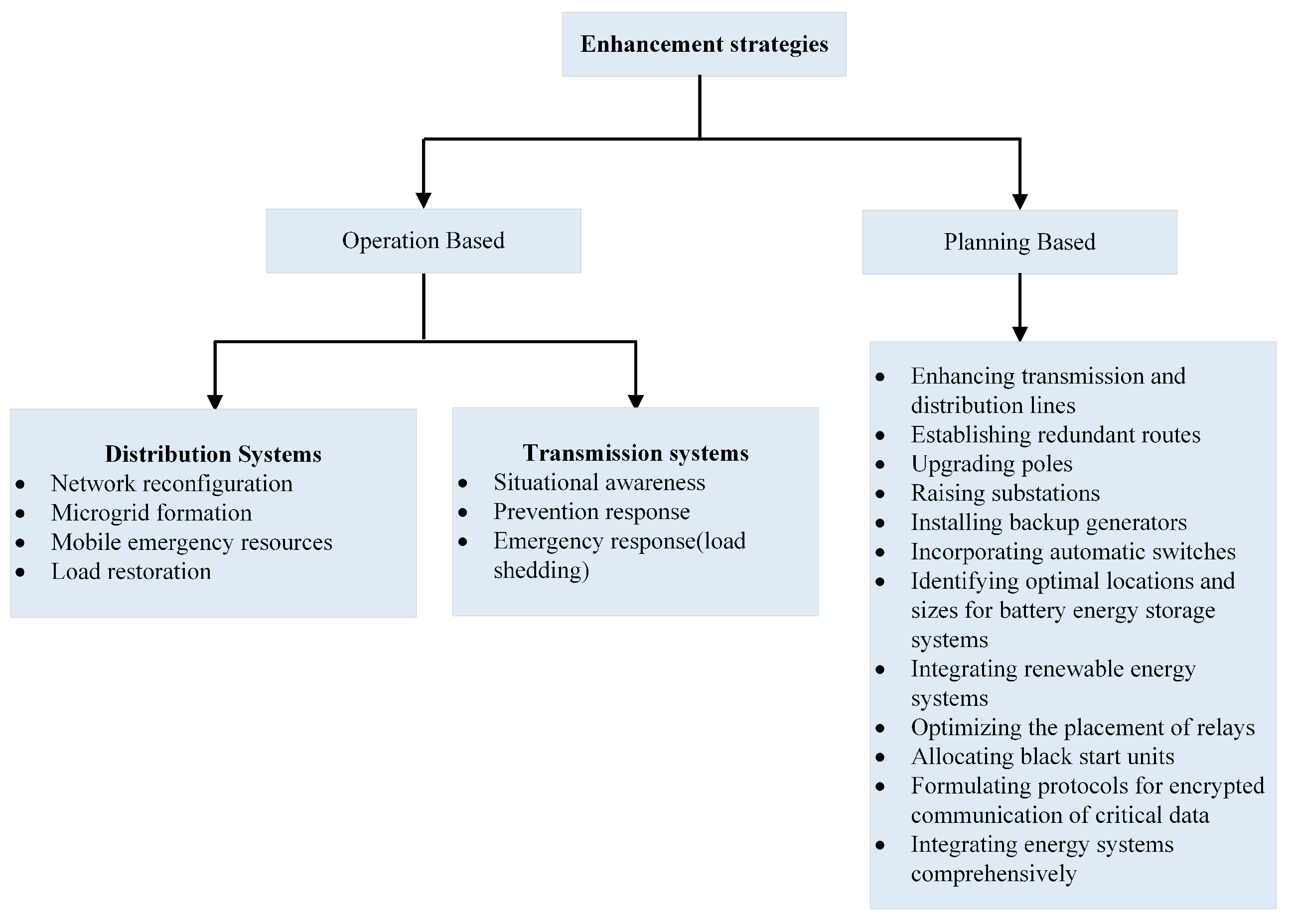
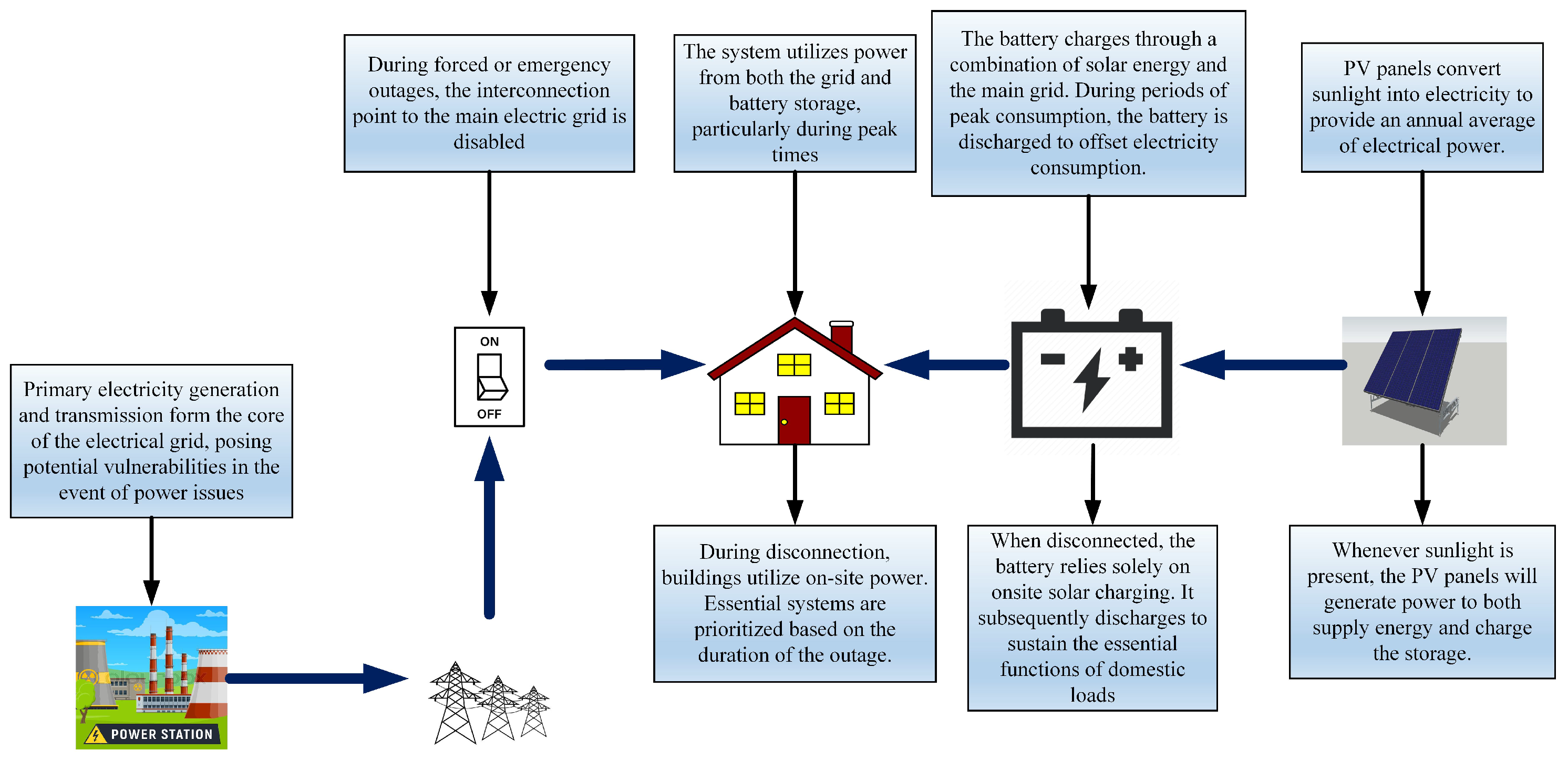
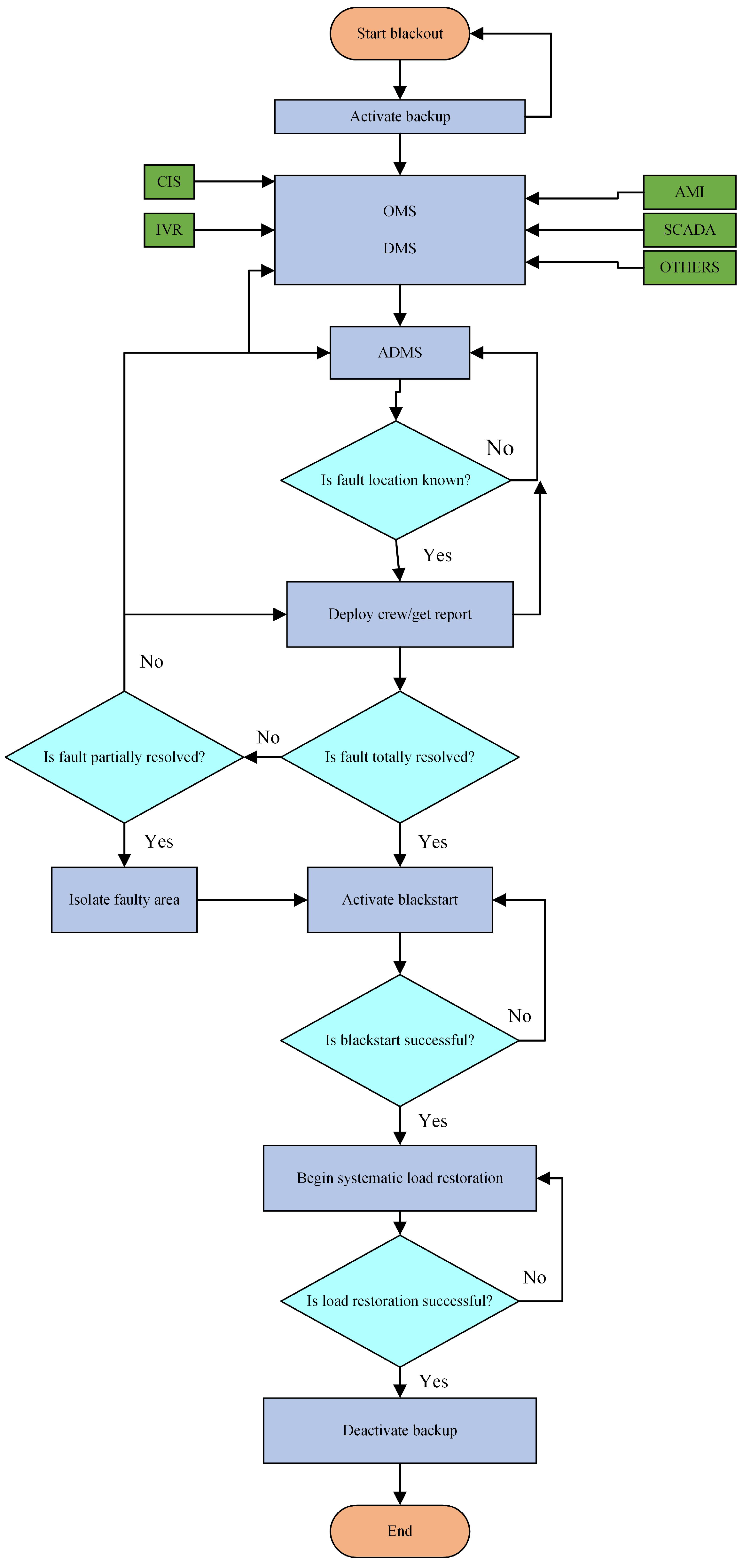
| Ref. | Application | Framework | Contributions | Constraints/Challenges |
|---|---|---|---|---|
| Arif et al. [25] | Pre-disaster | Mixed-integer linear programming | Reduced expenses related to depots, crews, equipment, and penalties incurred due to delays in equipment acquisition and restoration. | Solving problems on a large scale poses computational challenges. |
| Kotikot et al. [26] | Hurricanes | MCDA | Identified viable locations for the power storage devices. | A thorough assessment is required to avoid conflicting objectives; all places are not suitable for this approach; energy supply and demand analysis is not considered in this framework. |
| Sun et al. [27] | Typhoons | Monte Carlo simulation | Modeled the fragility of distribution lines and assessed the resilience of distribution systems during typhoon disasters. | Due to insufficient data, the fragility modeling of distribution lines has not been tackled. |
| Wang et al. [28] | Typhoons | Probabilistic generation model, spatio-temporal vulnerability model, breadth-first search algorithm | This research quantified the uncertainty associated with typhoons, determined the likelihood of failure for each distribution grid line, and computed the ideal amount of load reduction required for each segment. | The impact arising from the interactions between adjacent lines remains a significant issue. |
| Arab et al. [29] | Wildfires | 3LD | A 3LD framework has been established, wherein the primary defense involves wildfire prevention, the secondary defense focuses on wildfire mitigation and proactive response, and the tertiary defense centers on wildfire recovery preparedness. | Due to profound uncertainty, risk modeling poses significant challenges, and the physics of wildfires were beyond the paper’s scope. |
| Trakas et al. [30] | Wildfires | Monte Carlo simulation | A framework for emergency situations has been developed, taking into account the effects of wildfires on the conductor’s temperature and the functionality of the line. | This model is limited to constant loads. |
| Yao et al. [31] | All weather conditions | A duality-based column and constraint generation (D-CCG) method is proposed. | Integrated planning is conducted for the expansion of transmission and the optimal allocation of BESS resources for sectionalized-based BS. | The techniques developed are limited to the transmission level. |
| Luo et al. [14] | Critical loads | Monte Carlo method | The comparison and analysis involved assessing the load loss rate of the system, either before or after the integration of distributed generation, along with variations in the resilience of the distribution network. | This method will not work for transmission and distribution networks simultaneously. |
| Liu et al. [32] | Renewable energy systems | Stochastic optimization | Considered the uncertainty associated with RESs, and loads were also taken into account to enhance the capacity of distributed RESs in supporting critical load restoration. | The challenge involves implementing initial decisions for a load-restoration process and continuously adapting to fluctuating RES outputs and load forecast with a rolling optimization method. |
| Kim et al. [33] | Mobile energy storage | Stochastic optimization with the DSO-DERMS interaction frame | Developed an approach to enhance the investment efficiency of the distribution system operator in mobile energy storage units. | The capacity of ES units is limited. Accommodating more ES units for full load shedding is not economically viable. |
| Weather Condition | Consequence | Remedial Measures (Hardening/Long-Term Measures) |
|---|---|---|
| Temperature effects [8,47] |
|
|
| High winds, storms, and hurricanes [48,49,50] |
|
|
| Ice and snow [51] |
|
|
| Lightning [52] |
|
|
| Rains [8] |
|
|
| Floods [8] |
|
|
| Landslides [8] |
|
|
| Droughts [53] |
|
|
Disclaimer/Publisher’s Note: The statements, opinions and data contained in all publications are solely those of the individual author(s) and contributor(s) and not of MDPI and/or the editor(s). MDPI and/or the editor(s) disclaim responsibility for any injury to people or property resulting from any ideas, methods, instructions or products referred to in the content. |
© 2024 by the authors. Licensee MDPI, Basel, Switzerland. This article is an open access article distributed under the terms and conditions of the Creative Commons Attribution (CC BY) license (https://creativecommons.org/licenses/by/4.0/).
Share and Cite
Kasimalla, S.R.; Park, K.; Zaboli, A.; Hong, Y.; Choi, S.L.; Hong, J. An Evaluation of Sustainable Power System Resilience in the Face of Severe Weather Conditions and Climate Changes: A Comprehensive Review of Current Advances. Sustainability 2024, 16, 3047. https://doi.org/10.3390/su16073047
Kasimalla SR, Park K, Zaboli A, Hong Y, Choi SL, Hong J. An Evaluation of Sustainable Power System Resilience in the Face of Severe Weather Conditions and Climate Changes: A Comprehensive Review of Current Advances. Sustainability. 2024; 16(7):3047. https://doi.org/10.3390/su16073047
Chicago/Turabian StyleKasimalla, Swetha Rani, Kuchan Park, Aydin Zaboli, Younggi Hong, Seong Lok Choi, and Junho Hong. 2024. "An Evaluation of Sustainable Power System Resilience in the Face of Severe Weather Conditions and Climate Changes: A Comprehensive Review of Current Advances" Sustainability 16, no. 7: 3047. https://doi.org/10.3390/su16073047
APA StyleKasimalla, S. R., Park, K., Zaboli, A., Hong, Y., Choi, S. L., & Hong, J. (2024). An Evaluation of Sustainable Power System Resilience in the Face of Severe Weather Conditions and Climate Changes: A Comprehensive Review of Current Advances. Sustainability, 16(7), 3047. https://doi.org/10.3390/su16073047








